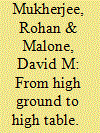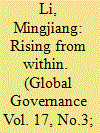| Srl | Item |
| 1 |
ID:
107434


|
|
|
|
|
| Publication |
2011.
|
| Summary/Abstract |
Independent India's multilateral strategy was designed defensively as a means to provide the country with some leeway in an intensely competitive bipolar world. Today, India casts itself as an emerging power intent on exerting the bilateral and multilateral influence that the country's founding leaders had long aspired to. Obsolete frameworks such as nonalignment and developing world leadership have mostly been jettisoned in the process. However, questions remain about India's willingness and capacity to take on global responsibilities to match its global aspirations. This article traces the evolution of India's multilateral approach and examinest is multilateral stance through several prisms: the UN Security Council, the World Trade Organization, global climate change negotiations, and some emerging international groupings of states in which India plays a role. Among our conclusions is that, in India's diplomacy, much depends on domestic factors.
|
|
|
|
|
|
|
|
|
|
|
|
|
|
|
|
| 2 |
ID:
107435


|
|
|
|
|
| Publication |
2011.
|
| Summary/Abstract |
What impact will the rise of China have on the existing international system? This article attempts to provide some clues for a better understanding of this issue by examining China's views on and policy toward international multilateralism in general and some of the newly emerging multilateral mechanisms in particular, including the Group of 20 and the BRICS. The article concludes that while China will become more proactive in its multilateral diplomacy, in many cases selectively, and increase its influence in global multilateral settings, various concerns and constraints will make it unlikely for China to completely overhaul or even dramatically reshape the multilateral architecture at the global level. China is likely to repeat its pattern of the past decade in East Asian regional multilateralism: participation, engagement, pushing for cooperation in areas that would serve Chinese interests, avoiding excessive responsibilities, blocking initiatives that would harm its in terests, and refraining from making grand proposals. In addition, China is stuck in defining its identity, and caught up between posturing as a leader of the developing world on some issues and siding with the developed countries on other policy issues. Given all of these constraints, China's involvement in global multilateralism is likely to be guided by pragmatism rather than grand visions. The article also argues that China will most likely strive to rise from within the existing international order. Washington should be prepared to plan its China policy on this basis and Sino-US relations will be shaped largely by the dynamics of contentions for power and interest as well as cooperation and coordination between China and the United States in various multilateral in stitutions.
|
|
|
|
|
|
|
|
|
|
|
|
|
|
|
|